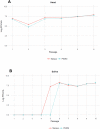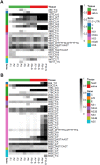Experimental Adaptation of the Yellow Fever Virus to the Mosquito Aedes albopictus and Potential risk of urban epidemics in Brazil, South America
- PMID: 30254315
- PMCID: PMC6156417
- DOI: 10.1038/s41598-018-32198-4
Experimental Adaptation of the Yellow Fever Virus to the Mosquito Aedes albopictus and Potential risk of urban epidemics in Brazil, South America
Abstract
Despite the availability of an efficient vaccine, Yellow fever (YF), a viral disease transmitted by mosquitoes, is still a threat. In Brazil, the yellow fever virus (YFV) has been restricted to a jungle cycle for more than 70 years. However, YFV has recently invaded populated cities in the Southeast such as Rio de Janeiro where the opportunistic mosquito Aedes albopictus is well established. Using in vivo passages of YFV in Ae. albopictus, we have selected viral strains presenting substitutions in NS1 gene. We did 10 passages of YFV-74018 on two distinct Ae. albopictus populations: (i) Manaus collected from a YFV-endemic area in Amazonia and (ii) PNMNI from a YFV-free area in the state of Rio de Janeiro. Full viral genomes were deep sequenced at each passage. We obtained two YFV strains presenting a non-synonymous substitution in the NS1 gene. Interestingly, they intervened at two different positions in NS1 gene according to the mosquito population: I2772T in Ae. albopictus Manaus and S3303N in Ae. albopictus PNMNI. Both substitutions reached fixation at the passage 10. Our data suggest that YFV has the potential for adaption to Ae. albopictus thereby posing a threat to most cities in South America where this mosquito is present.
Conflict of interest statement
The authors declare no competing interests.
Figures





References
-
- Gómez Mariela Martínez, Abreu Filipe Vieira Santos de, Santos Alexandre Araujo Cunha dos, Mello Iasmim Silva de, Santos Marta Pereira, Ribeiro Ieda Pereira, Ferreira-de-Brito Anielly, Miranda Rafaella Moraes de, Castro Marcia Gonçalves de, Ribeiro Mario Sergio, Laterrière Junior Roberto da Costa, Aguiar Shirlei Ferreira, Meira Guilherme Louzada Silva, Antunes Deborah, Torres Pedro Henrique Monteiro, Mir Daiana, Vicente Ana Carolina Paulo, Guimarães Ana Carolina Ramos, Caffarena Ernesto Raul, Bello Gonzalo, Lourenço-de-Oliveira Ricardo, Bonaldo Myrna Cristina. Genomic and structural features of the yellow fever virus from the 2016–2017 Brazilian outbreak. Journal of General Virology. 2018;99(4):536–548. doi: 10.1099/jgv.0.001033. - DOI - PubMed
Publication types
MeSH terms
LinkOut - more resources
Full Text Sources
Other Literature Sources

